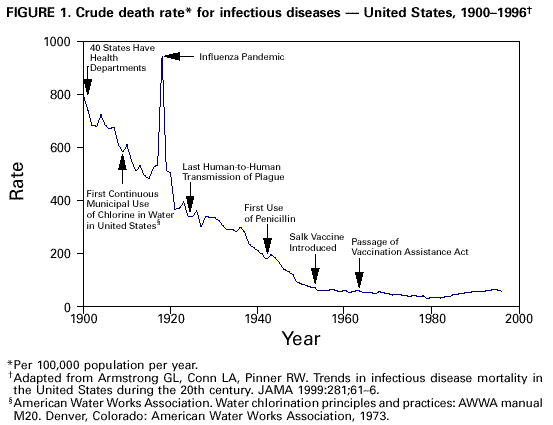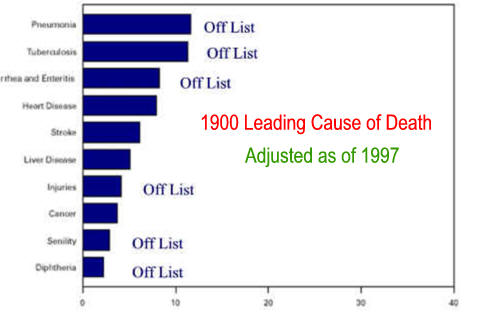|
Decade Grade
|
Terrible Events
6 points each |
Bad Events
2 points each |
Not Good Events
1 point each |
Rest of the Story
|
1930-39
1
18 |
Great Depression
Dust Bowl
12 points |
Bonus Army Killings
Scottsboro Boy Racial
Injustice
Memorial Day Massacre kills 10
strikers 6 |
|
Keynes won the battle with classical economists
or did he? Scottsboro most famous of many atrocities |
1950-59
2A
12 |
Asian
Flu kills 70,000
6
|
Korean
War4
Cold War5
Race Turmoil 6
|
2 Small
Recessions
Red Scare 2
|
Economic Expansion
grew the middle
class. |
1910-19
2B
12 |
Flu
Pandemic
kills 500,000
6 |
Labor Unrest
WW I4
Measles kills 12,000 children3
6 |
|
Progressive Era Continued as US slowly begins
to take on social responsibilities like the hookworm
parasite which made tired many southern workers and students. |
|
1940-49
4A 8 |
War II4
6 |
Cold War5 begins
2 |
|
Marshal Plan rebuilt Europe and also helped U.S economy.
Truman Doctrine
hoped to contain
fears about communism. |
|
2000-09
4B
8 |
|
Terrorism
Two Local Wars4
cc
Dotcom Bubble Great
Recession 8
|
|
Voters accepted Two Tax Cuts and
Medicare D expansion but will not increased federal debt.
Terrorism cost much affects few. |
|
1960-69
6
7 |
|
4 Assassinations Social Unrest
Cold War Heats Up4
Vietnam War 6 |
Polio
Epidemic
3
1
|
War, Segregation and a Cultural Revolution dominated the decade.
|
Years 1968,
1969, and 1970 had many noticeable events:
the early baby boomers moving into their 20’s;
the assassinations of Martin
Luther King Jr. and Robert Kennedy;
the beginning of the women’s movement; the draft,
the bombing of Cambodia, unrest on college campuses. Woodstock, Stonewall... |
Did any of these increase the impatience of the country in a permanent way?
There are likely stories that could be woven, undoubtedly more than one,
but it is unclear whether anything could be tested.
The question is probably too big, but the fact is interesting. Source
See
World
Getting Better
55 min. video |
1970-79
7A
6 |
|
2
Oil Crises
Boston
desegregation busing crisis
4 |
Watergate
Iran Hostages 2 |
Elderly hurt by Inflation and an
inadequate safety net. |
1990-99 7B
6 |
AIDS3
kills 200,000
6
|
|
|
Middle Class Wage Stagnation Continued as more
free trade increased foreign competition which began in the 1970's with the
rust belt. |
|
1900-09
9A
4 |
|
Labor l Unrest
Sever
Recession 4 |
|
Progressivism began a movement away from oligopoly power toward Public
Social
Responsibility.
US Yellow Fever3 eliminated. |
1980-89
9C
4 |
|
Severe Recession
AIDS3
4 |
|
Ronald Reagan Cut Taxes deregulation era began,
middle income wages stagnation continued with pain eased by newly named home
equity loans, government
debt plus future entitlement liabilities exploded. |
2010-19 9D
4 |
|
Stagnate Economy
Voter Consternation
4 |
|
Great Recession Ended Quickly as government printed what
could be money,
Medicare Part D increased those with government subsidized health care, slow
economic recovery increased middle income white males consternation caused
by help for minorities including gays, competition from women and
finally transgender rights. |
|
"The 2010s Broke Our Sense Of Time"
.
In the 20 months between Hillary Clinton’s campaign announcement and Trump’s
inauguration, everything from Apple Music to HBO Now to Apple News launched or
relaunched; the Amazon Echo, Google Home, and Apple Watch hit the full market;
publishers established the current form and tone of the news push alerts that
you receive; Facebook launched a live streaming function and then reprioritized
the function when people aired violence; Integra launched the ephemeral,
in exhaustive stories, so you can share — as they put it — “everything in
between” the moments you care about; Twitter introduced the quote-tweet option,
which formalized and democratized a function from the earlier days of Twitter,
and transformed every Trump tweet into an opportunity for commentary.
And, within a few months in 2016, both the primary catalog for millions of lives
(Instagram) and the primary channel for news and culture (Twitter) switched from
chronological to algorithmic timelines. All this happened while the country
realized Trump could become
president, and then he did — an experience somehow both mystifying and like
watching a wet paper bag break.
The 2000s were a bad decade, full of terrorism, financial ruin, and war. The
2010s were different, somehow more disorienting, full of molten anxiety, racism,
and moral horror shows. Maybe this is a reason for the disorientation: Life had
run on a certain rhythm of time and logic, and then at a hundred different entry
points, that rhythm and that logic shifted a little, sped up, slowed down, or
disappeared, until you could barely remember what time it was.
|
1920-29 9E
4 |
|
Post WW I Recession
Stock Market Crash 4 |
|
Economy Expanded as Wall Street and
Business Helped Rebuild Europe. Late 1929 crash would affect many. |



